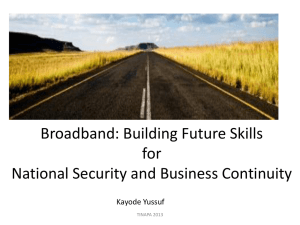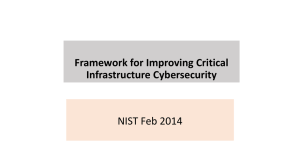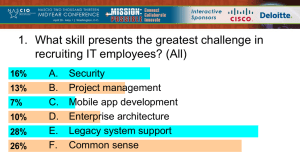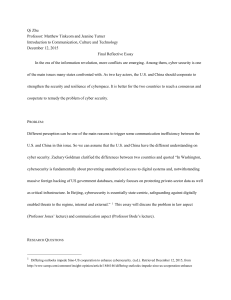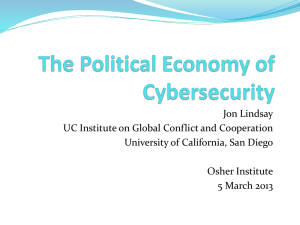Susan Kohn Ross, Esq. Mitchell Silberberg & Knupp LLP
advertisement
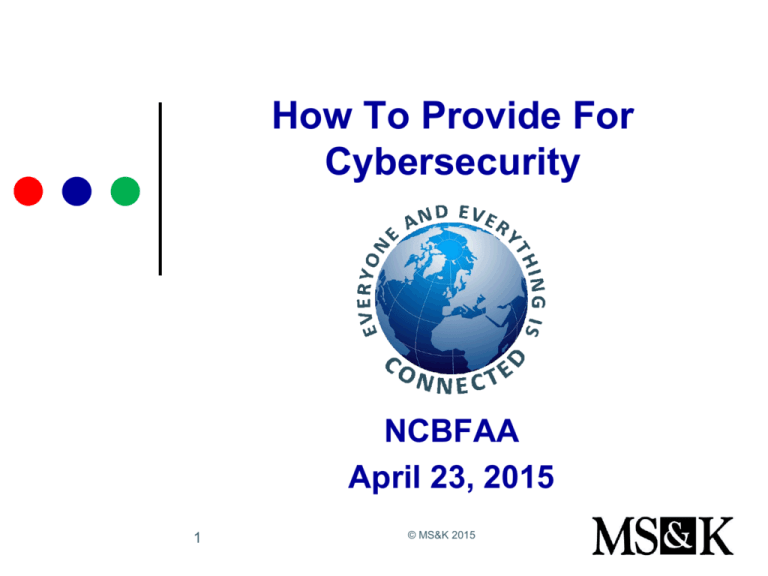
How To Provide For Cybersecurity NCBFAA April 23, 2015 1 © MS&K 2015 Susan Kohn Ross, Esq. Mitchell Silberberg & Knupp LLP 11377 West Olympic Boulevard Los Angeles, CA 90064 (310) 312-3206, Fax (310) 231-8406 skr@msk.com www.msk.com 2 © MS&K 2015 2 If the device can be connected to the Internet, it is susceptible to be hacked – especially with infected USB drives 3 © MS&K 2015 3 What Is At Risk? Everything you take for granted: • Customer and employee details, • Contracts, • Access to funds, • Telephone, email, social media and IM communication, and • All your files and records – company and personal. 4 © MS&K 2015 4 What Is In Your System? Valuable/Sensitive Information: 5 Customers’ information (contact details, payment information, pass/code words, building/security system layout, etc.). Employee information (SSN, payroll info., etc.). Business information (trade secrets, customer account information, etc.). Confidentiality duty/obligation. © MS&K 2015 5 Duty of Confidentiality Customs broker – 19 C.F.R. 111.24 Forwarder/NVOCC/3PL – principalagency relationship 6 © MS&K 2015 6 Estimated Costs 7 $300 billion to $1 trillion a year globally. Center for Strategic and International Studies Study by McAfee in 2014 – “In the Dark.” In 2013, the average cost of cybercrime incurred by a benchmark U.S. organization was $11.56 million, with a range of $1.3 million to $58 million. Ponemon Institute. Average of 122 successful attacks per week, up from 102 attacks weekly in 2012. The average cost to resolve a hack is approximately $1 million. © MS&K 2015 7 Key Issues PRIVACY SECURITY IP PRODUCT SAFETY BUSINESS SECRETS BUSINESS SECRETS 8 © MS&K 2015 DELIVERY SERVICES POSTAL SERVICES OTHER 8 Hackers’ Motives Criminal intent Corporate espionage State actors 9 © MS&K 2015 9 Cybersecurity Victims High Profile: Target, Home Depot, JP Morgan, eBay, AT&T, Michaels, Anthem, etc. However, …. Small Businesses! Hackers are generally opportunistic, going for “lowhanging fruit.” Source: Cybersecurity in the Golden State, California Attorney General/DOJ (Feb 2014) 10 © MS&K 2015 10 Cyber Security Prevention “The likelihood of a data breach is no longer a question; it is almost a certainty.” -- Experian, 2014 Data Breach Industry Forecast “There is probably no database that cybercriminals cannot compromise.” -- Adm. Michael S. Rogers, Director of the National Security Agency, in light of JP Morgan security breach in October 2014 11 © MS&K 2015 11 Is Prevention Possible? Why so challenging? Attackers have high incentives to intrude and little deterrence • Cybercrime is more lucrative than illegal drugs • A network of highly organized groups, often connected with traditional crime groups Businesses have low (immediate) incentives to invest in breach prevention Indefinitely and exponentially evolving threats (8,000-10,000 new vulnerabilities a year; “zero”-day attacks) 12 © MS&K 2015 12 Is There Really a Problem? 13 © MS&K 2015 13 Background • • • 14 Maritime industry cybersecurity is very lax or low level. State-of-the-art firewall and antivirus software is ineffective in keeping out dedicated attacks. Social engineering tactics work very well. © MS&K 2015 14 Property Security Does Not Equal Cybersecurity • • 15 When Cyberkeel asked about cybersecurity protection in the maritime industry, the answers received generally had to do with keeping intruders out. Few answered in the context of detecting intruders once in their systems. Frequent Question - “How do we operate given the knowledge that we may at any time be compromised?” © MS&K 2015 15 Maritime Examples - Cyberkeel 2011: cyber attack on IRISL – the Iranian container carrier Damaged all IRISL’s data related to: rates, cargo, dates, places, parties, etc. There was a simultaneous elimination of the company’s internal communication network. 16 © MS&K 2015 16 Other Examples - Cyberkeel • • • • 17 Icefog: backdoor access to Japanese, Taiwanese and Korean companies (extract documents, gain email access, obtain passwords). Bypass Australian customs. Destabilization of a drilling platform. Shut down of a drilling platform by malware infection. © MS&K 2015 17 More Examples - Cyberkeel • • • • 18 Complete compromise and spoofing of AIS – ship tracking system. GPS jamming. Manipulation of electronic data. Remote navigation of an $80 million yacht using $3,000 worth of equipment. © MS&K 2015 18 And even more examples • • • 19 Smuggling drugs and deleting containers from a terminal’s computer system. Stealing money through man-in-themiddle attacks. Zombie Zero: Using barcode scanners to gain entry to financial systems – TrapX – manipulated the data. © MS&K 2015 19 Cyberkeel Findings Cyberkeel evaluated the top 50 container carriers’ websites • 37 appear completely open to simple attacks towards back-end systems. • 6 allow harvesting of usernames. 20 © MS&K 2015 20 More Findings - Cyberkeel • • • 21 8 carriers, controlling 38% of global trade, allow “password” as a password to access sensitive eCommerce applications. 2 carriers allow “x” as a password. Spoof domains are in place for 10 of the top 20 carriers. © MS&K 2015 21 Senate Armed Services Committee Report “Inquiry into Cyber Intrusions Affecting U.S. Transportation Command Contractors.” Report period - June 2012 to March 2013. Declassified and released September 17, 2014. 22 © MS&K 2015 22 Senate Report - More Most contractors are civilian airlines (some 30 or so which make about 90% of the passenger moves for Defense and have more than 1/3 of the bulk cargo capacity) and vessel operators (which in 2012 moved about 95% of Defense’s dry cargo). 23 © MS&K 2015 23 Successful Intrusions Into the controlling computer of a vessel at sea, separately into that of an airplane and also into a logistics provider’s system! Obtained emails, documents, flight details, credentials and personal identification numbers, user accounts, passwords (some for encrypted emails) and source codes. 24 © MS&K 2015 24 What Happened? Hackers were Chinese - so national security and espionage involved. Phishing email used – an email masquerading as coming from a trustworthy entity. 25 © MS&K 2015 25 Relevant Standards Federal – no statute, but the NIST standards; federal prosecutors use several statutes to gain convictions. States – 45+ have adopted related privacy and notice laws – and each is different. 26 © MS&K 2015 26 Prosecuting Cyber Crimes 18 U.S.C. 1030 (1986) Unauthorized access Exceeding authorized access Mail and wire fraud Conspiracy Are supply chain security standards enough? 27 © MS&K 2015 27 Supply Chain Security C-TPAT – AEO. Mutual recognition – Canada, EU, Japan, Jordan, Korea, New Zealand and Taiwan. Human trafficking. Lost or damaged cargo. 28 © MS&K 2015 28 Information Technology Security – Customs Brokers Measures must be in place to safeguard computer access and information. Identify the abuse of IT including improper access, tampering or the altering of business data. All system violators must be subject to appropriate disciplinary actions for abuse. 29 © MS&K 2015 29 Password Protection Automated systems must use individually assigned accounts that require a periodic change of password. IT security policies, procedures and standards must be in place and provided to employees in the form of training. 30 © MS&K 2015 30 System and Data Protection 31 Anti-virus and anti-spyware should be installed and kept current in Customs Broker computer systems susceptible to infiltration. © MS&K 2015 31 Information Technology Security – Consolidators/3PLs 32 Information Technology (IT) integrity must be maintained to protect data from unauthorized access or manipulation. © MS&K 2015 32 Password Protection 33 Automated systems must use individually assigned accounts that require a periodic change of password. IT security policies, procedures and standards must be in place and provided to employees in the form of training. © MS&K 2015 33 Accountability 34 A system must be in place to identify the abuse of IT including improper access, tampering or the altering of business data. All system violators must be subject to appropriate disciplinary actions for abuse. © MS&K 2015 34 Framework For Action C-Suite Attention Pre-Breach Actions Post-Breach Remedies 35 © MS&K 2015 35 C-Suite Attention Cybersecurity is no longer “just” for the IT Director. Headaches from BYO devices. Cost – benefit balancing. Leadership should be paying attention to and managing IT system risks. 36 © MS&K 2015 36 Pre-Breach Issues/Measures Regulatory Framework/Standards. Vulnerability Assessments/IT Protections. Training and SOPs (frequent training, regular SOP reviews and updates, backup and testing, strong passwords, physical access controls, limits on the use of USB drives). Emergency Preparedness Plan to include outside supporting experts, including counsel, technology and insurance. 37 © MS&K 2015 37 Post-Breach Crisis Management 38 Secure Your System Contact Counsel, Insurer, PR Team, and possibly Law Enforcement Comply with Data Breach Notification Laws Implement Your Preparedness Plan © MS&K 2015 38 Post-Breach Issues 39 Preserve evidence/do not turn off computers. Confirm what data you have and what is on or off-site in the hands of third parties, including employees and vendors. Complete a forensics investigation to determine the nature and severity of the incident. Implement emergency preparedness/business continuity plan - who says what to whom, when and how? PR: Tell the truth without creating judicial admissions; maintain control over the information and your credibility. Bring in an expert to interact with the government and the media (Counsel, PR and IT). Reevaluate/reassess your emergency response plan and insurance coverage. © MS&K 2015 39 National Institute of Standards and Technology 40 © MS&K 2015 40 NIST Special Publication 800-122 Personally identifiable information or PII is "any information about an individual maintained by an agency, including (1) any information that can be used to distinguish or trace an individual‘s identity, such as name, social security number, date and place of birth, mother‘s maiden name, or biometric records; and (2) any other information that is linked or linkable to an individual, such as medical, educational, financial, and employment information." 41 © MS&K 2015 41 Commercial Definition – PII Individual’s name – along with one of the following Social Security No. Driver’s License No. or Financial account number in combination with any security code, access code, or password. 42 © MS&K 2015 42 Federal Standard 43 © MS&K 2015 43 Background Improving Critical Infrastructure Cybersecurity – EO 13636 – February 2013 Cybersecurity Framework – NIST Standards – February 2014 Promoting Private Sector Cybersecurity Information Sharing – EO 13691 – February 2015 44 © MS&K 2015 44 NIST Standards Elements Identify Recover Protect Respond 45 Detect © MS&K 2015 45 Facebook Threat Exchange Facebook, Printerest, Tubmlr, Twitter, Yahoo, Dropbox and Bit.ly. The stated goal is to locate malware, the source domains and the IP addresses which are involved as well as the nature of the malware itself. https://threatexchange.fb.com/. 46 © MS&K 2015 46 Executive Order - EO 13691 47 “Strongly” encourages the development and formation of Information Sharing and Analysis Organizations (ISAOs) National Cybersecurity and Communications Integration Center is to engage in “continuous, collaborative and inclusive coordination with ISAOs on the sharing of information related to cybersecurity risks and incidents”. © MS&K 2015 47 ISAOs ISAOs are to develop voluntary standards for “robust” information sharing regarding risks and incidents, including automated information sharing mechanisms Standards for members to include • • • • • • 48 Contract language Business processes Operating procedures Technical means Privacy protections Be consistent with voluntary international standards © MS&K 2015 48 Paying the Piper 49 © MS&K 2015 49 Legal Fallout From An Intrusion Federal and state investigations. Internal investigatory costs. Legal, forensic specialist, firings, terminations, process changes, system expenses (hard and soft), reputation and so on. Shareholder derivative actions. Class action lawsuits. 50 © MS&K 2015 50 Internal Investigation – Initial Questions 1) Are there government agencies to which we are obliged to give notice about what happened? If so, is there a specific time frame under which we must act? 2) What do we tell our customers and clients, and when? 3) What do we tell our staff, and when? 4) Who on our staff was involved and what punishment is merited? Is our only choice to fire the people involved? 51 © MS&K 2015 51 Investigation – Initial Questions 5) When do we tell our Board? Shareholders? Should we report what happened to law enforcement? If so, to what agency and when? 6) If a vendor was involved, must we change vendors? If so, how quickly? Can we afford to cut off that vendor? 52 © MS&K 2015 52 Investigation – Best Practices Call your outside lawyer, then jump right in. Preserve all available evidence as soon as possible and before meeting with witnesses. Chase down all reasonable leads, regardless of where they might take you, ask the tough questions, and be flexible. 53 © MS&K 2015 53 Steps To Take – Assess/Verify Vet Your Business Partners State Requirements Clearly Employee Awareness and Training Clear SOPs which are followed and documented Cybersecurity Insurance 54 © MS&K 2015 54 Insider Threat Secret Service Study of Insiders Attacks 55 81% planned their actions in advance, 81% were motivated by financial gain, 23% acted out of revenge, 33% were identified as difficult, and 17% were disgruntled. © MS&K 2015 55 What Needs To Be Done? • • • Increased awareness re the real threat picture. Develop plans and countermeasures. Improved training and awareness – • 56 C-level plus all staff and vendors. © MS&K 2015 56 Your Contracts Customer Agreement: Privacy provisions Limitation of liability Specific risks re data breach Disclosures/disclaimers regarding data risks Minimize sensitive data retained Consent to recording 57 Electronic Contracts/Signature © MS&K 2015 57 More Thoughts Should there be industrywide cybersecurity standards? Given the current anti-trust and other limitations, should a trusted environment be created in which companies may share cyber attack information? 58 © MS&K 2015 58 Final Thought! Should C-TPAT/AEO be expanded to include cybersecurity? 59 No – but what else is there? © MS&K 2015 59 60 © MS&K 2015 60 It Really Is All About Due Diligence 61 © MS&K 2015 61 Questions? 62 © MS&K 2015 62 MITCHELL SILBERBERG & KNUPP LLP Website: www.msk.com Washington, D.C. New York, NY Los Angeles, CA Office: 310-312-3206 Fax: 310-231-8406 63 © MS&K 2015 63

